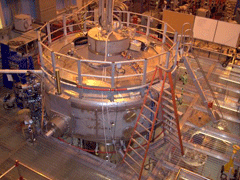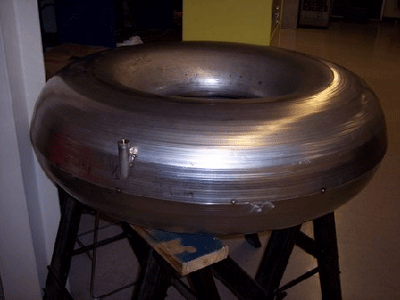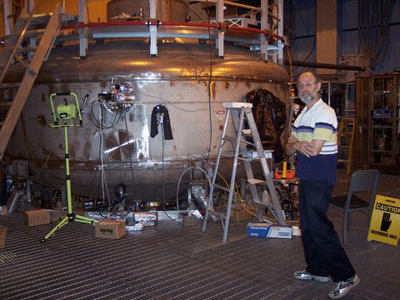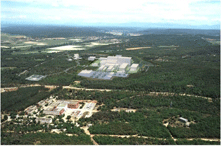Some Like It Hot....
Air Date: Week of September 30, 2005

The Levitating Diapole Experiment at MIT is designed to achieve fusion, or the energy of the stars, on Earth. (Photo: Bruce Gellerman)
Today, a special report on the once and future source of power, the atom. Einstein’s theory of relativity proved that great forces could be unleashed if large atoms were split. But, even greater energies could be freed if small atoms could be fused together. Bruce Gellerman reports on the scientists who are trying to do just that.
Transcript
CURWOOD: From the Jennifer and Ted Stanley Studios in Somerville, Massachusetts, this is Living on Earth. I'm Steve Curwood.
Today, a special report on the once and future source of power, the atom.
[MUSIC: Bohumir Kryl “Oh Promise Me (1905)” from ‘The Black Wax Sampler, 1902-1912: Wax Cylinder Phonograph Recordings’ (Tin Foil - 2001)]
CURWOOD: We begin a hundred years ago when, at the age of 26, Albert Einstein came up with the radical notion that would forever change our concepts of time, space and the link between mass and energy.
EINSTEIN: The equation e is equal to m c-squared, in which energy is put equal to mass, multiplied by the square of the velocity of light, showed that very small amounts of mass may be converted into a very large amount of energy and vice versa.
CURWOOD: Einstein’s Theory of Relativity told us that great forces could be unleashed if large atoms were split, and even greater energies freed if small ones could be fused together. Large atoms like uranium naturally fall apart, decaying with radiation, so it didn’t take scientists long to figure out how to ignite that process, and explode a bomb or run a power plant. But it’s much harder to fuse atoms together in the continuous way the sun turns hydrogen into helium.
Bruce Gellerman has our report on the people who are trying to do just that.
GELLERMAN: It’s easy to see why many scientists say fusion is the energy source of the future. The primary fuel is a form of hydrogen called deuterium, and scientist Michael Swartz says there are oceans of it.
SWARTZ: In every cubic mile of sea water is enough deuterium to produce equal energy to all the earth’s reserves. So if we can tap it, we would essentially have a limitless form of energy for the planet.
GELLERMAN: Not only that, fusion is virtually non-polluting. There are no greenhouse gases. And the waste product is helium, the stuff in toy balloons.
SWARTZ: What it offers is a chance to power the United States with an economy that does not produce pollution.
GELLERMAN: Sound too good to be true? Well, that’s the promise physicists have been making since they began work on fusion in the 1950s. And they have come up with two very different visions of fusion’s future: one hot, one cold.
We’ll have more about cold fusion later. But first –
[DOOR OPENS]
GELLERMAN: Earl Marmar , a senior scientist at MIT, unlocks a door mainstream physicists say is the surest route to fusion energy.
MARMAR: So, this is our control room…
GELLERMAN: Inside Marmar‘s laboratory, researchers huddle over banks of computers. There are video monitors everywhere.
MARMAR: This is where the scientists, the students and engineers hang out when we’re actually operating an experiment which we are today. Today’s a run day.
GELLERMAN: This lab looks and sounds like the control room at a lunar space launch.
[COUNTDOWN…10-9…]
GELLERMAN: But physicists here are aiming higher than the moon..
[…8-7-6….]
GELLERMAN: They want to create the power of the stars.
[…5-4…ENTERING PULSE…MACHINE YAWNS]
GELLERMAN: Thirty times a day, four days a week, Earl Marmar and his team of scientists send a pulse of electric current through the experimental fusion reactor they call Alcator C Mod. And, for a few brief moments, they create energies found only in the stars.
COUNTDOWN VOICE: Entering recool.
GELLERMAN: So, that’s it?
MARMAR: That’s it, yeah, that was a successful shot. We had a nice two second pulse, and now we’re going to study what happened on that pulse.
GELLERMAN: So, you went to 60 million degrees in there?

This superconducting magnetic ring weighs half a ton and will levitate inside the LDX to produce a huge magnetic field. (Photo: Bruce Gellerman)
GELLERMAN: The 100 ton Alcator C Mod experimental fusion reactor is exciting science, as big and as expensive as it gets on the MIT campus. Alcator is a 4th generation Tokamak design. The name is a Russian acronym describing the shape: Tokamaks look like giant stainless steel donuts. There are about 20 in the world. This one here at MIT is the most advanced.
GELLERMAN: So can you show me the machine?
MAMAR: Well, actually, it’s locked up. Because when we’re operating we don’t allow people to go out there and look at it. It’s about 50 yards in that direction, through those doors and then another big five foot thick concrete door.
GELLERMAN: The concrete door protects workers in the control room from getting zapped by high energy neutrons produced when Alcator C is up and running. But compared to fission reactors – which use uranium – fusion reactors like Alcator are safer. It produces one-millionth of the radioactive waste and there’s no chance of a meltdown.
MAMAR: Can’t happen. No, there’s so little fuel in these devices, an uncontrolled reaction isn’t possible. It’s so hard to make fusion happen. You don’t have to worry about that.
GELLERMAN: The reason it’s so hard to make fusion happen is easy to understand. Take two toy magnets and try to get the like poles to stick together. You can’t because like charges repel. It’s the same thing with fusion. The nuclei of the deuterium fuel are positively charged and getting them to fuse requires huge amounts of energy. In the center of stars, gravity does the job.
On Earth, physicists reproduce a star’s gravity by surrounding their Tokamak donuts with powerful magnets. Alcator C mod has three of them. The force field squeezes the deuterium atoms tighter and tighter until the electrons are torn away, leaving the nuclei to zip around the donut at a thousand miles a second, colliding and fusing and creating temperatures in the hundreds of millions of degrees.
GELLERMAN: How do you get your data? Why don’t your instruments melt?
MARMAR: Well, the instruments aren’t inside the plasma, they’re outside.
GELLERMAN: Something’s gotta be sensing it.
MARMAR: Yeah, that’s visible light. That’s coming out on the plasma so it comes through a window and goes into a TV camera , a fancy TV camera, but it’s a TV camera.
GELLERMAN: The trick is controlling the turbulent fuel in the reactor – keeping the nuclear particles away from the walls of the donut where they rapidly cool. The ultimate and, so far, elusive goal, says Earl Marmar, is a sustained reaction – one that produces more energy than it takes to trigger it.
MARMAR: Right now, Tokamaks generally run in a pulse mode. For example, for us it’s a few seconds; some of the bigger machines can run for tens of seconds. But in the end we want to a reactor to be running steady state.
GELLERMAN: Building a fusion reactor that can run steady state for six minutes…Device that can sustain a fusion reaction was final, now seems within reach, possibly.
That’s a thermonuclear reaction that once ignited runs on its own. In the summer of 2005, after more than a decade of heated negotiations, the U.S., the EU, France, Russia, South Korea, China and Japan decided the path to a steady state reactor would be: ITER, it’s an acronym for the International Thermonuclear Experimental Reactor. ITER is designed to demonstrate the technical and scientific feasibility of fusion based upon the Tokamak design.
|
Construction is set for 2006. And when it’s finished, ITER is expected to produce 400 megawatts of fusion energy for more than six minutes. That’s twice as much energy as it needs to jumpstart the reaction and 25 times as much energy as today’s most powerful Tokamak.
Ray Orbach, director of the U.S. Energy Department’s Office of Science, was at the Moscow press conference when it was announced that ITER would be built in the south of France.
ORBACH: The excitement we feel is that’s a design goal. But there is every possibility that we would get four times that amount by lets the end of operating period, say 10 years after operations began. If we can do that, we’re within shouting distance of what a commercial power plant would require.
GELLERMAN: Orbach says, faced with the threat of global warming produced by burning fossil fuels and the ever-rising demand for oil, the future of the planet depends on ITER’s success. But he admits it’s a gamble.
ORBACH: Remember, this is a burning plasma that has never been constructed before, and it’s a challenge.
GELLERMAN: In time, and with enough money, a fusion reactor is technologically feasible. But will it ever make financial sense?
GARWIN: I’m quite confident that we’ll have fusion energy, more energy out than we put in.
GELLERMAN: Physicist Richard Garwin is IBM fellow emeritus at the Watson Research Center, winner of the nation’s highest science honor.
GARWIN: Whether that will be economical in comparisons with other sources of energy is another question. That’s a very big question.
GELLERMAN: In the mid-1990s, Congress raised the same question and didn’t like the answers it was getting from physicists. Despite major advances in understanding the complexity of fusion, lawmakers were frustrated by the slow progress physicists were making. The Clinton administration had pulled out of the ITER project, drastically cut funding for Tokomak research, and then went looking for alternative methods for achieving fusion. No idea was deemed too far out. Not even Jay Kesner’s.
KESNER: About 10 years ago I got interested in a new approach to fusion different from the mainstream.
GELLERMAN: Jay Kesner, a senior scientist at MIT, calls himself one of the kooks in the plasma fusion field. Kesner came up with a radical design for a fusion reactor, finding inspiration in the heavens.
GELLERMAN: This thing looks like a flying saucer.

Senior scientist Jay Kesner stands next to the Levitating Diapole Experiment at MIT. (Photo: Bruce Gellerman)
KESNER: Yeah, before we put the floor in it, it looked like a lunar lander.
GELLERMAN: Jay Kesner stands next to what he calls his levitating dipole experiment. Ten feet high, and 18 wide, the device looks like a giant, squished stainless steel pumpkin. Actually, the LDX is modeled after the planet Jupiter. Why Jupiter? Well, in the 1980’s astrophysicists made a surprising discovery. A flyby voyage of Jupiter revealed its magnetic field controlled a huge, dense plasma, nearly perfect for fusion. Kesner is trying to duplicate the feat. But in order to pull it off he had to use a magicians trick: levitation. Suspended inside the LDX vacuum chamber is a half-ton magnet.
KESNER: So, it’s like taking a planet and making a big hole in the middle so that the magnetic field lines don’t hit the planet. And that’s exactly why we want to have a magnet that has a hole in the middle, that looks like a bagel. That’s sitting there free in space, and you want it to be sitting floating freely because supports will scrape off the plasma.
GELLERMAN: And that would prevent fusion. At six million dollars, the LDX is the cheapest and simplest fusion device yet conceived. And, potentially, it could operate more efficiently at lower temperatures than the far more expensive and complex Tokamaks.
Sustaining a steady state fusion reaction would be a technological tour de force, but sustaining a steady flow of research funds has proven even more difficult. Ninety-five percent of the research money comes from the federal government, and Miklos Porkolab, director of MIT’s Plasma Science and Fusion Center, says the half-life of Washington’s interest in fusion is short.
PORKOLAB: If we had gotten the money 30 years ago, what we asked for to develop fusion, then we would probably have it now working. But we never got the money. We got one third. You can’t achieve fusion if you don’t give the funding to build the devices that we need.
GELLERMAN: Scientists say their goal is a commercial fusion reactor by 2050. But in the past their predictions have been overly optimistic and the goal line keeps moving. In the 1950s, physicists predicted they’d have a fusion reactor by 1970. Then it was 1990, leading critics to quip there’s a new constant in phsyics: fusion in 20 years. Robert Park writes a column for the American Physical Society dedicated to debunking scientific claims.
PARK: The joke is that fusion is the energy source of the future, and always will be.
CURWOOD: And one way forward may involve going back to the future. In just a moment, Bruce Gellerman continues our report on fusion with an update on the technology that first thrilled, then chilled, the scientific community back in the 1980’s—cold fusion. Stay tuned to Living on Earth.
[MUSIC: Aqueduct “Tension” from ‘I Sold Gold’ (Barsuk Records – 2005)]
Links
Living on Earth wants to hear from you!
Living on Earth
62 Calef Highway, Suite 212
Lee, NH 03861
Telephone: 617-287-4121
E-mail: comments@loe.org
Newsletter [Click here]
Donate to Living on Earth!
Living on Earth is an independent media program and relies entirely on contributions from listeners and institutions supporting public service. Please donate now to preserve an independent environmental voice.
NewsletterLiving on Earth offers a weekly delivery of the show's rundown to your mailbox. Sign up for our newsletter today!
 Sailors For The Sea: Be the change you want to sea.
Sailors For The Sea: Be the change you want to sea.
 The Grantham Foundation for the Protection of the Environment: Committed to protecting and improving the health of the global environment.
The Grantham Foundation for the Protection of the Environment: Committed to protecting and improving the health of the global environment.
 Contribute to Living on Earth and receive, as our gift to you, an archival print of one of Mark Seth Lender's extraordinary wildlife photographs. Follow the link to see Mark's current collection of photographs.
Contribute to Living on Earth and receive, as our gift to you, an archival print of one of Mark Seth Lender's extraordinary wildlife photographs. Follow the link to see Mark's current collection of photographs.
 Buy a signed copy of Mark Seth Lender's book Smeagull the Seagull & support Living on Earth
Buy a signed copy of Mark Seth Lender's book Smeagull the Seagull & support Living on Earth


